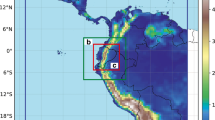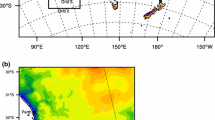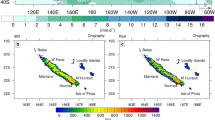Abstract
Persistent shifts in mean rainfall have wide-ranging impacts to hydrology and water availability, and a reliable set of climate projections of change to mean rainfall is a useful tool for future planning. Most climate models project a decrease in winter rainfall in southern Australia, however there is a wide model range and there is not yet a robust assessment of underlying physical processes that can inform and constrain projections. Here, a multiple linear regression model between indices of atmospheric circulation and gridded rainfall in observations and in CMIP5 climate models is developed for July, representing the peak of winter. The regression is used as an evaluation tool for models and a basis to select models. Spatial distributions of the coefficients from the regression illustrate the relative important of different circulation features for rainfall across the region, and illustrate where climate models have deficiencies. As an additional check of projections, historical years that are an analogue for the projected future mean state of the atmospheric circulation are identified and the rainfall anomaly during those years is examined. Both approaches broadly agree and support previous work in suggesting a constraint on rainfall change to a decrease only. The regression analysis also suggests that the median projection for southwest Western Australia should be revised lower than the median of all climate models. The results demonstrate value in applying statistical techniques to understand relationships of rainfall to circulation and to refine confidence in regional climate projections.







Similar content being viewed by others
References
Antonsson K, Chen D, Seppä H (2008) Anticyclonic atmospheric circulation as an analogue for the warm and dry mid-Holocene summer climate in central Scandinavia. Clim Past 4:215–224
Australian Bureau of Meteorology (2019) Australian Gridded Climate Data (AGCD)/AWAP; v1.0.0 Snapshot (1900-01-01 to 2018-12-31) https://doi.org/10.4227/166/5a8647d1c23e0
Charles SP, Bates B, Smith IN, Hughes JP (2004) Statistical downscaling of daily precipitation from observed and modelled atmospheric fields. Hydrol Process 18:1373–1394
Corney SP, Grose MR, Bennett JC, White CJ, Katzfey JJ, McGregor JL, Holz GK, Bindoff NL (2013) Performance of downscaled regional climate simulations using a variable-resolution regional climate model: Tasmania as a test case. J Geophys Res Atmos 118:1–15
CSIRO and Bureau of Meteorology (2015) Climate Change in Australia, Technical Report. Melbourne, Australia. www.climatechangeinaustralia.gov.au
Eyring V et al (2019) Taking climate model evaluation to the next level. Nat Climate Change. https://doi.org/10.1038/s41558-018-0355-y
Flato G et al (2013). Evaluation of climate models. In: Stocker TF, Qin D, Plattner G-K et al (eds) Climate change 2013: the physical science basis. Contribution of working group I to the fifth assessment report of the intergovernmental panel on climate change. Cambridge University Press, Cambridge, pp 741–866. https://doi.org/10.1017/CBO9781107415324.020
Frederiksen JS, Frederiksen CS (2007) Interdecadal changes in southern hemisphere winter storm track modes. Tellus 59:599–617
Frederiksen CS, Grainger S (2015) The role of external forcing in prolonged trends in Australian rainfall. Clim Dyn 45:2455–2468
Frederiksen JS, Webster PJ (1988) Alternative theories of atmospheric teleconnections and low-frequency fluctuations. Rev Geophys 26:459–494
Frederiksen CS, Frederiksen JS, Sisson JM, Osbrough SL (2017) Trends and projections of Southern Hemisphere baroclinicity: the role of external forcing and impact on Australian rainfall. Clim Dyn 48:3261–3282
Fu G, Charles SP, Chiew FHS, Ekström M, Potter NJ (2018) Uncertainties of statistical downscaling from predictor selection: equifinality and transferability. Atmos Res 203:130–140
Grose MR, Bhend J, Argueso D, Ekström M, Dowdy AJ, Hoffmann P, Evans JP, Timbal B (2015) Comparison of various climate change projections of eastern Australian rainfall. Aust Meteorol Oceanogr J 65:72–89
Grose MR, Risbey JS, Moise AF, Osbrough S, Heady C, Wilson L, Erwin T (2017) Constraints on Southern Australian rainfall change based on atmospheric circulation in CMIP5 simulations. J Clim 30:225–242
Grose MR, Syktus J, Thatcher M, Evans JP, Ji F, Rafter T, Remenyi T (2019) The role of topography on projected rainfall change in mid-latitude mountain regions. Clim Dyn. https://doi.org/10.1007/s00382-019-04736-x
Hope PK et al (2015) Seasonal and regional signature of the projected southern Australian rainfall reduction. Aust Meteorol Oceanogr J 65:54–71
Hoskins BJ, Valdes PJ (1990) On the existence of storm-tracks. J Atmos Sci 47:1854–1864
Jézéquel A, Yiou P, Radanovics S (2018) Role of circulation in European heatwaves using flow analogues. Clim Dyn 50:1145–1159
Jones DA, Wang W, Fawcett R (2009) High-quality spatial climate data-sets for Australia. Aust Meteorol Oceanogr J 58:233–248
Knutti R, Sedláček J, Sanderson BM, Lorenz R, Fischer EM, Eyring V (2017) A climate model projection weighting scheme accounting for performance and interdependence. Geophys Res Lett 44:1909–1918
Kobayashi S et al (2015) The JRA-55 reanalysis: general specifications and basic characteristics. J Meteorol Soc Jpn Ser II 93:5–48
Mayewski PA et al (2017) Ice core and climate reanalysis analogs to predict Antarctic and Southern Hemisphere climate changes. Quat Sci Rev 155:50–66
Mearns LO, Hulme M, Carter TR, Leemans R, Lal M, Whetton PH (2001) Climate scenario development. In: Houghton J et al (eds) IPCC third assessment report. The science of climate change. Cambridge University Press, Cambridge, pp 739–768
O’Kane TJ, Risbey JS, Franzke C, Horenko I, Monselesan DP (2013) Changes in the metastability of the midlatitude southern hemisphere circulation and the utility of nonstationary cluster analysis and split-flow blocking indices as diagnostic tools. J Atmos Sci 70:824–842
Parsons S, Renwick JA, McDonald AJ (2016) An assessment of future southern hemisphere blocking using CMIP5 projections from four GCMs. J Clim 29:7599–7611
Pepler A, Alexander L, Evans J, Sherwood S (2015) Zonal winds and southeast Australian rainfall in global and regional climate models. Clim Dyn. https://doi.org/10.1007/s00382-015-2573-6
Phillips NA (1951) A simple three-dimensional model for the study of large-scale extratropical flow patterns. J Meteorol 8:381–394
Pook MJ, Risbey JS, McIntosh PC, Ummenhofer CC, Marshall AG, Meyers GA (2013) The seasonal cycle of blocking and associated physical mechanisms in the Australian region and relationship with rainfall. Mon Weather Rev 141:4534–4553
Risbey JS, McIntosh PC, Pook MJ (2013a) Synoptic components of rainfall variability and trends in southeast Australia. Int J Climatol 33:2459–2472
Risbey JS, Pook MJ, McIntosh PC (2013b) Spatial trends in synoptic rainfall in southern Australia. Geophys Res Lett 40:3781–3785
Sanderson BM, Wehner M, Knutti R (2017) Skill and independence weighting for multi-model assessments. Geosci Model Dev 10:2379–2395
Taylor KE, Stouffer RJ, Meehl GA (2012) An overview of CMIP5 and the experiment design. Bull Am Meteorol Soc 93:485–498
Tibaldi S, Molteni F (1990) On the operational predictability of blocking. Tellus A 42:343–365
Timbal B, Fernandez E, Li Z (2009) Generalization of a statistical downscaling model to provide local climate change projections for Australia. Environ Model Softw 24:341–358
van Vuuren D et al (2011) The representative concentration pathways: an overview. Clim Change 109:5–31
Whetton P, Hennessy K, Clarke J, McInnes K, Kent D (2012) Use of representative climate futures in impact and adaptation assessment. Clim Change 115:433–442
Wilby R, Greenfield B, Glenny C (1994) A coupled synoptic-hydrological model for climate change impact assessment. J Hydrol 153:265–290
Woollings T et al (2018) Blocking and its response to climate change. Curr Clim Change Rep 4:287–300
Acknowledgements
This work was supported by the Australian Government’s National Environmental Science Program (NESP) Earth System and Climate Change (ESCC) hub. We acknowledge the World Climate Research Programme’s Working Group on Coupled Modelling, which is responsible for CMIP, and we thank the climate modelling groups for producing and making available their model output. James Risbey is supported by the CSIRO Decadal Climate Forecasting Project.
Author information
Authors and Affiliations
Corresponding author
Additional information
Publisher's Note
Springer Nature remains neutral with regard to jurisdictional claims in published maps and institutional affiliations.
Electronic supplementary material
Below is the link to the electronic supplementary material.
Rights and permissions
About this article
Cite this article
Grose, M.R., Foster, S., Risbey, J.S. et al. Using indices of atmospheric circulation to refine southern Australian winter rainfall climate projections. Clim Dyn 53, 5481–5493 (2019). https://doi.org/10.1007/s00382-019-04880-4
Received:
Accepted:
Published:
Issue Date:
DOI: https://doi.org/10.1007/s00382-019-04880-4




